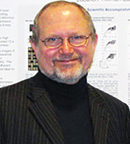
Steven A. Rosenberg, MD, PhD
STEVEN A. ROSENBERG, MD, PhD, Chief of Surgery at the National Cancer Institute (NCI), began his pioneering research in adoptive cell transfer using interleukin (IL)-2 in the mid-1970s. His IL-2 studies were among the clinical trials that led to the first U.S. Food and Drug Administration approval of an immunotherapy in the 1990s, for the treatment of metastatic renal cell carcinoma and metastatic melanoma. Studying the tumors of patients with metastatic melanoma, Dr. Rosenberg subsequently identified immune cells called tumor-infiltrating lymphocytes, which appeared to be key to the body’s immunologic defense against cancer. Adoptive cell transfer with tumor-infiltrating lymphocytes is an immunotherapeutic approach akin to current treatments with chimeric antigen receptor (CAR) T-cell therapy, but it is an easier process, according to investigators. Now, the treatment is producing responses in patients who do not respond to checkpoint inhibition.

Amod Sarnaik, MD
At the 2018 Society for Immunotherapy of Cancer (SITC) Annual Meeting, Dr. Rosenberg shared his experience with tumor-infiltrating lymphocyte therapy in checkpoint inhibitor–naive patients.1 Amod Sarnaik, MD, of Moffitt Cancer Center, Tampa, described his experience with this approach in previously treated patients in the phase II C-144-01 trial.2
Simpler Than CAR-T Therapy
THE PROCESS involves taking a small resected sample of the tumor, propagating its resident lymphocytes ex vivo, allowing antitumor activity to grow, and then administering the final tumor-infiltrating lymphocytes product back into the patient. The treatment leverages and enhances the patient’s natural defenses against cancer with a single infusion, after the microenvironment is optimized by lymphodepletion. The entire process can be completed within 22 days, at least for the cryopreserved product tested in Dr. Sarnaik’s study.
“We’re out beyond 10 years in some cases, so very likely [adoptive cell transfer of tumor-infiltrating lymphocytes] is a curative treatment for patients with metastatic melanoma.”— Steven A. Rosenberg, MD, PhD
Tweet this quote
“Unlike with CAR T cells, where we take circulating peripheral blood mononuclear cells, genetically manipulate them, and hope they home back to the tumor, tumor-infiltrating lymphocytes have already had success at arriving at the tumor in the first place,” Dr. Sarnaik said.
Efficacy in Treatment-Naive Patients
DR. ROSENBERG reported on 194 consecutive patients with metastatic melanoma treated at the NCI before checkpoint inhibitors became available. The median follow-up on these patients is almost 7 years.
Objective responses were observed in 55%, with complete responses seen in 24%. Of the 46 complete responders, 2 patients have recurred (at 19 months and 27 months). Responses are ongoing for 14 to 152 months. In all but two patients, a complete response was achieved with a single infusion of tumor-infiltrating lymphocytes, Dr. Rosenberg reported.
“Cell transfer therapy can mediate durable regressions in patients with metastatic cancer refractory to other treatments. The overall survival rate is 39% for all patients, but only 2 responders have recurred. We’re out beyond 10 years in some cases, so very likely this is a curative treatment for patients with metastatic melanoma,” he said. “Adoptive cell transfer of tumor-infiltrating lymphocytes appears able to eliminate the last melanoma cell.”
Efficacy in Previously Treated Patients
PREVIOUSLY TREATED patients were evaluated in a multicenter phase II study presented by Dr. Sarnaik. The study evaluated cryopreserved autologous tumor-infiltrating lymphocyte therapy (LN-144, lifileucel) in 47 patients with unresectable advanced melanoma who had received at least a single prior treatment (average of 3.3) and have a relatively large tumor burden. All had disease progression on drugs targeting programmed cell death protein 1 (PD-1), and patients with BRAF mutations also had disease progression on BRAF and/or MEK inhibitors.
“The majority of patients who had not derived clinical benefit from anti–PD-1 antibodies had a response to this adoptive cell therapy.”— Amod Sarnaik, MD
Tweet this quote
The treatment was highly active in patients who had never responded to prior anti–PD-1 therapy but not in those with prior initial responses to checkpoint inhibition. “The majority of patients who had not derived clinical benefit from anti–PD-1 antibodies had a response to this adoptive cell therapy,” Dr. Sarnaik reported.
Manufacturing Process
LIFILEUCEL WAS manufactured in 22 days. Portions of the patient’s tumor are sent to a central manufacturing site, where they undergo fragmentation and are cultured with interleukin-2 (IL-2), which encourages the tumor-infiltrating lymphocytes to exit the tumor and become established. The resulting tumor-infiltrating lymphocytes are hyperstimulated, and upon expansion they are harvested, concentrated, cryopreserved, and shipped to participating sites. Patients undergo nonmyeloablative lymphodepletion, followed by up to 6 doses of IL-2 (or to tolerance). Lifileucel is then thawed and infused.
“With a central manufacturing site, this is a uniform process across treatment centers. Patients can reside and be treated at sites that lack on-site manufacturing facilities,” he explained.
For 95% of patients, this process was successful. In a single injection, an average of 26 billion tumor-infiltrating lymphocytes were infused.
High Level of Disease Control
INVESTIGATOR-ASSESSED objective responses were observed in 18 of the 47 consecutively infused patients (38%), including 1 patient with a complete response. An additional 18 patients achieved stable disease, for a disease control rate of 77%.
A total of 7 patients (15%) had progressive disease as their best response. Four patients were not evaluable yet. The median duration of response was 6.4 months, with ongoing responses ranging from 1.3 to 14 months at this time. Of 43 evaluable patients, 72% had a reduction in tumor burden.
“Clinically meaningful responses were demonstrated, and time to response was relatively short, averaging 2.4 months,” reported Dr. Sarnaik. “Interestingly, all but one of the responders had not responded to previous anti–PD-1 therapy.”
Toxicity
AS EXPECTED for a treatment regimen that includes nonmyeloablative chemotherapy, hematologic toxicity was common, including thrombocytopenia, neutropenia, and anemia. These grade ≥ 3 adverse events were observed in 80.9%, 53.2% and 53.2%, respectively, and other adverse events were consistent with the adoptive cellular therapy experience in general and the administration of IL-2. One patient with liver metastases died of an intra-abdominal hemorrhage likely related to the tumor, and another died of respiratory failure.
Adverse events peaked early, typically around the time of lymphopenia and high-dose IL-2 administration. These side effects diminished after 2 weeks, “reflecting the advantage of a single treatment rather than multiple treatments over time,” he said.
“Preliminary data support lifileucel autologous tumor-infiltrating lymphocytes as an efficacious and well-tolerated therapeutic option for patients with metastatic melanoma. We have demonstrated that patients with prior anti–PD-1 treatment can derive benefit,” Dr. Sarnaik said.
Additional Commentary
IN A BRISK question-and-answer period, several in attendance questioned why virtually no responses were seen in patients who had previously responded to anti–PD-1 therapy, whereas previous nonresponders derived benefit from lifileucel.
“I think some patients will just not have a meaningful immune response…. There will always be some patients who are resistant to any form of immunotherapy. Likely they have some new acquired mutation or a loss of human leukocyte antigen expression,” Dr. Sarnaik explained.
He also noted that the study, by requiring all patients to have experienced disease progression on anti–PD-1 agents, “selected the worst of the worst” and indicated “this is late-line treatment of patients who have no other acceptable treatment options.”

Michael Lotze, MD
Michael Lotze, MD, Professor of Surgery, Immunology, and Bioengineering at the University of Pittsburgh School of Medicine, noted that in the NCI study, which was initiated prior to the checkpoint era, 24% of patients responded but many of them were “declared late.” He pointed out that many of Dr. Sarnaik’s patients had short follow-up. “You may actually see more complete responses when you go out farther,” he told Dr. Sarnaik. ■
DISCLOSURE: Dr. Sarnaik has served as a consultant/advisor to Iovance Biotherapeutics, which sponsored this study, and B4CC Inc. Dr. Rosenberg reported no conflicts of interest. Dr. Lotze reported no conflicts of interest regarding this study; he is past Chief Scientific Officer of Iovance Biotherapeutics.
REFERENCES
1. Rosenberg SA: TIL therapy for melanoma and beyond—Lessons learned on optimal tumor rejection antigens for solid tumors. 2018 SITC Annual Meeting. Invited lecture. Presented November 10, 2018.
2. Sarnaik AA, Thomas S, Davar D, et al: Safety and efficacy of cryopreserved autologous tumor infiltrating lymphocyte therapy (LN-144, lifileucel) in advanced metastatic melanoma patients following progression on checkpoint inhibitors. 2018 SITC Annual Meeting. Abstract 022. Presented November 11, 2018.


